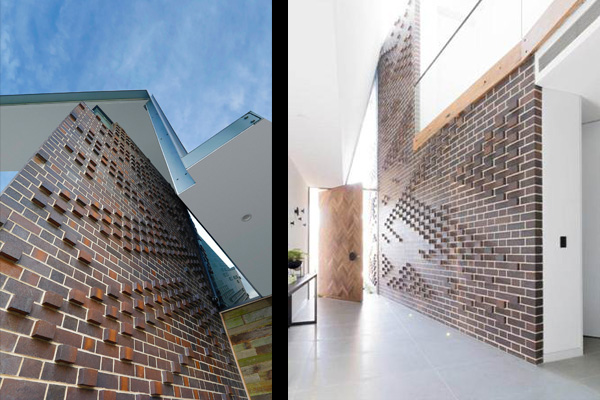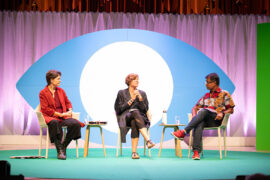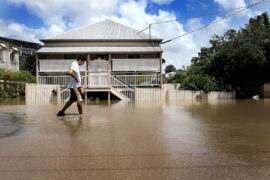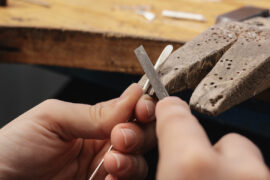PGH Mowbray Blue dry pressed bricks make a dramatic entrance at a contemporary Sydney residence.

August 29th, 2014
When John Jabbour from the Destech Building Group set out to design his new family home, located in the seaside suburb of Clovelly in Sydney, one of his primary design objectives was to balance his desire to create an ultra-modern, high-tech, contemporary home, with his personal preference for ‘heritage’ building materials. These materials, he believed, would help anchor the home to the site and its surrounding built environment.
It’s this eclectic mix of modern and heritage building products and techniques that would also enable John to maximise the footprint of his home, allowing him to take advantage of every square metre of the site’s limited size and irregular shape. This meant that each elevation was given due consideration and resulted in very specific decisions being made regarding product selection and placement.
Along the western boundary, for instance, a combination of dry pressed common bricks, sandstone, fibre cement sheeting, glass and timber panels in blackbutt and spotted gum were used to define the ground floor wall and boundary line. The boundary wall of the first floor utilised zinc panels mounted to a mansard roof – a design technique made famous during the 17th century. Incorporating this element in the build offsets the wall from the boundary, minimising the home’s visual impact on neighbouring properties and provides additional privacy. It also creates a dramatic internal void that features prominently in the overall house design.
In contrast, the eastern and rear elevation of the home was set back from the boundary line, enabling John to use a more conventional building technique. His preferred choice in this instance was to construct walls made from double brick, featuring PGH Mowbray Blue dry pressed face bricks for the outer skin and dry pressed commons for the inner skin. Dry pressed commons were also used for the majority of the internal dividing walls. From John’s perspective, solid pressed bricks are a practical and malleable design tool, offering a level of acoustic and thermal insulation that simply cannot be achieved with standard brick veneer or timber framed construction.
It’s at this point that John’s focus would turn to the home’s front elevation and its relationship to the streetscape. His inclination was to capitalise on the site’s angled frontage, which is aligned to the roadway, allowing him to maximise the building’s facade. To achieve this end, the structural steel frame that was used to create the mansard roof was cleverly angled and cantilevered to the site’s most northerly point. To support this roof line, a massive 100 year old ironbark timber beam that was salvaged from a historic Taree bridge was used to great effect.
The finishing touch, however, to this home’s most impressive facade is the seven metre high pixelated face brick wall that dominates the entry. This design element was initially inspired by a home originally created by leading Australian Architect, John Wardle. The application of face brick on this project resonated with John Jabbour and became a dominant element of his home’s final design.
This imposing sculptural feature wall uses Mowbray Blue dry pressed face bricks in a Flemish bond, punctuated with random protrusions to create a sense of drama, and although this can be clearly seen from street level, its grandeur is best appreciated ‘up close and personal.’
In line with John’s appreciation for ‘heritage’ building materials, his decision to use PGH Mowbray Blue dry pressed face bricks for this installation works perfectly with the more contemporary elements used in the build and reinforces his belief that modern architecture can successfully borrow from the past and still deliver into the future.
PGH Bricks & Pavers
pghbricks.com.au
INDESIGN is on instagram
Follow @indesignlive
A searchable and comprehensive guide for specifying leading products and their suppliers
Keep up to date with the latest and greatest from our industry BFF's!

For Aidan Mawhinney, the secret ingredient to Living Edge’s success “comes down to people, product and place.” As the brand celebrates a significant 25-year milestone, it’s that commitment to authentic, sustainable design – and the people behind it all – that continues to anchor its legacy.

London-based design duo Raw Edges have joined forces with Established & Sons and Tongue & Groove to introduce Wall to Wall – a hand-stained, “living collection” that transforms parquet flooring into a canvas of colour, pattern, and possibility.
Grey epoxy painted steel tube frame. Polypropylene seat. Indoor Use. Dimensions: H790 W350 Delivery Time: 12 Weeks Applications: Indoor Variations: 9 Colour variations Finish: Frame – grey apoxy painted steel. Shell – polypropylene
A moulded plastic shell and a series of soft cushions: these are the basic elements of the Husk armchair by Patricia Urquiola.
The internet never sleeps! Here's the stuff you might have missed

At the World Design Congress in London, a simple idea threaded through two dense days: design is not an island. It moves inside wider systems of economics, policy, finance and ecology.

David Gole, principal at leading climate-resilient design practice JDA Co., comments on the intersection between heritage and climate in architecture.

Having recently attended the Symposium as the Murcutt Pin-holder, Sydney-based architect Jamileh Jahangiri reflects on the importance of the gathering.

CPD Live’s final live-presented season for 2025 continues with a powerful Day 2 lineup, delving into façade weatherproofing, apartment design trends, smart bathrooms, and digital compliance. Starting from 9 AM AEDT, these free CPD-accredited sessions will help you finish the year with fresh insight and full compliance confidence.